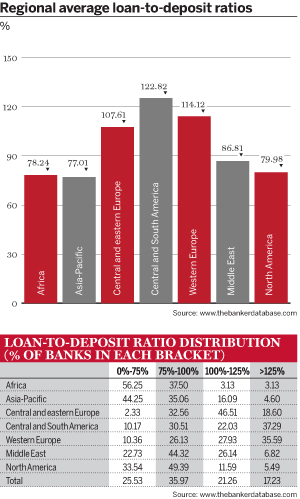Loan to deposit (LTD) ratios fell heavily in this year’s Top 1000. Among the 795 banks for which The Banker Database has this information, the ratio fell from 99% in the 2012 Top 1000 to under 94% in the 2013 figures.
The sole region in which the average LTD ratio increased significantly was Latin America. In this region it climbed from 111% to 123% between 2012 and 2013. In the Middle East there was an increase to 87%, but only a slight one from the 2012 figure of 85%.
LTDs declined everywhere else. Western Europe’s fell from 117% last year to 113% this year, as its institutions, hit by the eurozone crisis, continued to deleverage. This is the second year that the region’s average LTD ratio has decreased. It stood as high as 125% in the 2011 rankings.
The figure for North America fell too, but by a far smaller amount than in western Europe. That partly reflects the fact US and Canadian banks are starting from lower positions – their ratio stood at 82% in last year’s ranking and 80% in this year’s – and that much more corporate funding in those countries takes place in the capital markets in comparison to Europe, where bank lending is dominant.
The only two other regions with LTD ratios of 80% or less are Asia-Pacific and Africa. In Asia-Pacific the figure, at 77%, is the lowest globally. Africa’s ratio is barely higher. There, banks make just $78 of loans for every $100 of deposits they garner (the figure would be even smaller if banks from the continent’s biggest economy, South Africa, were excluded), suggesting they have plenty of scope to grow their lending.
Most African banks, 56% of them, have LTDs of less than 75%. That stands the continent in stark contrast with the rest of the world. In western Europe and Latin America, a mere 10% of banks have ratios of below 75%. In central and eastern Europe, almost 98% of them have LTDs of more than 75%.
Of the banks in the survey, 17% had ratios above 125%. The bulk of those – 101 out of 137 lenders in that bracket – came from western Europe and Latin America. In North America, just nine banks, or 5.5% of those from the region in the Top 1000, surpassed the 125% mark.
What will the figures look like next year? Predicting trends in LTD ratios is difficult and depends on several factors outside the control of banks, including their regulatory environment and economic conditions in the jurisdictions in which they operate. But, with western Europe’s economy unlikely to pick up much in the second half of 2013, and with banks still focused on cleaning up their balance sheets, LTDs in the region are probably going to remain similar to their current levels, if not fall further.
Latin America’s ratio has risen quickly in the past two years, from 99% in the 2011 rankings to 123% this year. While this growth could continue, it is not likely to do so at the same pace, given that many analysts are already voicing concern about overly high LTDs in countries such as Brazil and Chile.










